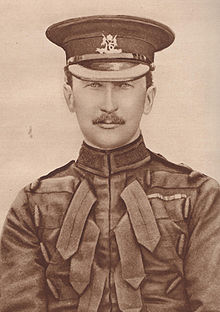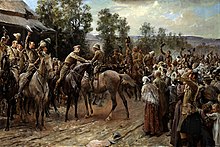Hubert Gough
Sir Hubert de la Poer Gough GCB , GCMG , KCVO (* 12. August 1870 in Gurteen , County Waterford , Ireland ; † 18th March 1963 in London ) was a British general and army commander in the First World War .
Life
Gough was born the eldest son of General Sir Charles John Stanley Gough , VC , GCB and raised in Eton and Sandhurst . In 1889 he joined the 16th Lancers as a lieutenant . He was a participant in the Tirah campaign in British India 1897-98. He then attended Staff College Camberley , but was recalled prematurely to South Africa when the Second Boer War broke out there in 1899 . Gough was first widely known as the leader of a mounted advance detachment of the column that terrified the trapped British garrison under George Stuart White during the siege of Ladysmith . In the battle of Blood River Poort he suffered a defeat by superior Boer troops and was briefly captured, but this did not seriously damage his reputation. From 1904 to 1906 he was an instructor at Staff College and was then given command of the 16th Lancers . In 1911 he was transferred to Curragh , Ireland , as Brigadier General , where he commanded the 3rd Cavalry Brigade. Here he was involved in the so-called " Curragh incident " in March 1914 .
When the First World War broke out in August 1914, he continued to command the 3rd Cavalry Brigade, but was soon promoted to major general and took over the 2nd Cavalry Division during the First Battle of Flanders . From April to July 1915 he was temporarily commander of the 7th Infantry Division and was then appointed as lieutenant general to commander of the 1st Corps , with which he fought in the Battle of Loos . In May 1916 he was given command of the newly formed reserve army , which took over part of the front during the Battle of the Somme in July 1916. In October 1916, the reserve army was renamed the 5th Army . With this he took part in the Third Battle of Flanders in 1917, after the failure of which he came under fire. In March 1918 his army was so badly affected during the German "Michael" offensive that it had to be disbanded and Gough was released from command. Douglas Haig later admitted that he had made Gough the scapegoat for the overwhelmingly accomplished German break-in.
In 1919 Gough was head of the Allied Military Mission in the Baltic States. This was his last active role and in 1922 he resigned from the military as a general. Gough was an avowed opponent of the Versailles Treaty and became an active member of the pacifist Union of Democratic Control . From 1936 to 1943 he was Colonel of Honor of the 16th / 5th The Queen's Royal Lancers . In 1939 he was temporarily reactivated as a colonel and head of an area command of the Home Guard and ended his service a second time in 1942.
Works (selection)
- The Fifth Army in the European war (1931)
- The March retreat: On the operations of the Fifth Army in the spring of 1918 (1934)
- Soldiering on: Being the Memoirs of General Sir Hubert Gough (1954)
literature
- Anthony Farrar-Hockley: Goughie: The life of General Sir Hubert Gough. Hart-Davis, MacGibbon, London 1975.
Web links
- Biography on historyofwar.org
- Bibliography on Hubert Gough
- Newspaper article about Hubert Gough in the 20th century press kit of the ZBW - Leibniz Information Center for Economics .
Individual evidence
- ↑ Union of Democratic Control at spartacus-educational.com , accessed June 8, 2019.
| personal data | |
|---|---|
| SURNAME | Gough, Hubert |
| ALTERNATIVE NAMES | Gough, Hubert de la Poer |
| BRIEF DESCRIPTION | British general |
| DATE OF BIRTH | August 12, 1870 |
| PLACE OF BIRTH | Gurteen , County Waterford |
| DATE OF DEATH | March 18, 1963 |
| Place of death | London |

